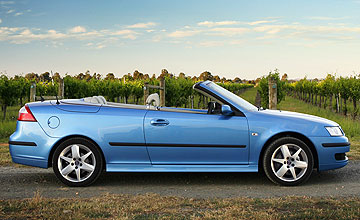BY BYRON MATHIOUDAKIS | 19th Jan 2007

Sure, the Swedish car a sweet-enough looking, with pleasant dynamics, brilliant four-cylinder petrol engines and a high degree of individuality compared to, say, most Toyota sedans.
Stand it besides any pre-1994 Saab 900, however, and the sad truth emerges. No upright windscreen no bank vault build quality no bespoke switchgear and controls no quirky design and, yes, too much of too many other cars make today’s 9-3 an Opel Vectra that’s been improved upon by the Swedes.
Is this what GM wanted when it purchased Saab in the late 1980s? In this case, genetically modified is right!
Now, we car nuts want to see Saab return to its individualistic roots, and we also believe that its far-too-neglectful caretakers have finally twigged to what the world has known since 1993, when the first all-too General Motors Saab arrived in the guise of the original 900’s replacement.
We also understand that if Saab actually uses the best of what GM has to offer today then it has a fighting chance of staying around to see the return of true Saab design and engineering tomorrow.
So welcome the 9-3 TiD, a turbo-diesel powered premium sedan, wagon and cabriolet that makes an appealing alternative to an Audi A4 TDI, while undercutting it (and the superior but much exxier BMW 320d) by a massive amount of dollars.
The engine installation seems a good one, with virtually no mechanical noise coming into the roof-down cabin of the drop-top, let alone the cocooned sedan and SportCombi wagon.
Acceleration is brisk, and gets stronger as the sweet-shifting six-speed manual gearbox or equally suitable six-speed automatic make the most of the TiD’s torque characteristics through the mid-ranges. In fact, for a diesel, this is quite a revvy little unit.
We prefer it to the current range of VW/Audi units.
So while the diesel cannot cure the Convertible’s at-times wobbly ride over Queensland’s patchy southern roads, its impressive overtaking punch and refined drivetrain means that the TiD is the most compelling model in the drop-top range – especially as nobody else in Australia (ever) has had the guts to go diesel in this image-sensitive segment.
Along with the dynamics, Saab also seems to have fiddled with the steering and suspension tune in the MY07 9-3s, because the handling is definitely more linear and involving than the last batch we drove.
To make sure this wasn’t limited to just the TiD models, we also sampled a new petrol-powered 9-3, to come to the same conclusion.
Indeed, while you would not call any 9-3 a driver’s car, the TiD is enjoyable to drive. In SportCombi guise, we believe Saab have a real winner, and a unique proposition in the crowded premium sector, since only the French, Alfa Romeo, VW and soon Volvo are willing to import diesel-engined wagons.
A flurry of other detail changes inside, most noticeable on the dashboard, which further strengthens the 9-3’s case, especially as Saab’s pricing really puts the model in up-spec mainstream Japanese territory.
While it is a GM unit found in a host of Opels and Vauxhalls, diesel and 9-3 are a great fit, and an encouraging first step in Saab’s crucial drive towards its cherished sense of individuality, initiative and independence.
A Swedish Corona, the 9-3 TiD, particularly in wagon and convertible formats, most definitely is not.